Sweet Corn
A few scattered European corn borer (ECB) moths have been captured in central and northern counties, and this insect is certainly active in southern parts of the state. Numbers are very low, which is consistent with the last few seasons. Whorl corn is the primary target for egg laying, but as yet, scouts have reported no signs of feeding injury in the few plantings that are of suitable maturity. In northern and central counties, corn plantings that were started on/under plastic have reached a size that will support ECB larvae. We expect to encounter some level of feeding over the next 2-3 weeks, although the majority of plantings have not required insecticide treatments for ECB prior to full tassel in the past several years.
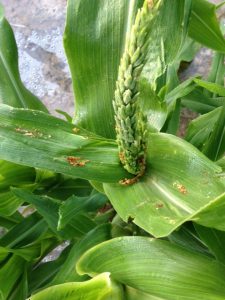 Look for the characteristic “shot-hole” type of feeding (photo below at right) and consider treating when infested plants exceed 12% in a 50 plant sample. As plantings proceed to the pre-tassel stage, ECB larvae may be found in emerging tassels (see photo at left). It is a good idea to treat individual plantings as they move into the full tassel/first silk stage one time. This eliminates any ECB larvae that have emerged with the tassels as they begin to move down the stalk to re-enter near developing ears.
Look for the characteristic “shot-hole” type of feeding (photo below at right) and consider treating when infested plants exceed 12% in a 50 plant sample. As plantings proceed to the pre-tassel stage, ECB larvae may be found in emerging tassels (see photo at left). It is a good idea to treat individual plantings as they move into the full tassel/first silk stage one time. This eliminates any ECB larvae that have emerged with the tassels as they begin to move down the stalk to re-enter near developing ears.
Useful insecticides for this particular application include synthetic 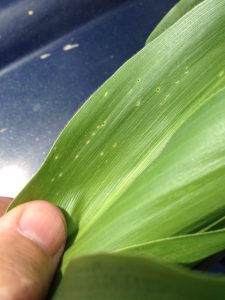 pyrethroids (IRAC Grp 3), spinosyns (including OMRI approved Entrust) IRAC Grp 5), and diamides such as Coragen or Vantacor (IRAC Grp 28) or materials such as Besiege which include the active ingredient in Coragen. Synthetic pyrethroids alone should NOT be used for corn earworm (CEW) protection on silking corn. Control with these materials is very inconsistent.
pyrethroids (IRAC Grp 3), spinosyns (including OMRI approved Entrust) IRAC Grp 5), and diamides such as Coragen or Vantacor (IRAC Grp 28) or materials such as Besiege which include the active ingredient in Coragen. Synthetic pyrethroids alone should NOT be used for corn earworm (CEW) protection on silking corn. Control with these materials is very inconsistent.
The highest nightly trap catches* of ECB for the week ending 5/22/24 are as follows:
| Asbury 1 | Georgetown 1 |
| Califon 1 | Sergeantsville 1 |
| Farmingdale 1 | South Branch 1 |
* No blacklight traps are in operation south of the Columbus (Burlington Co.) area this season.
Light corn earworm (CEW) catches occurred in pheromone traps this past week. Although there is little impact from these moths, their presence is a reminder that we now get a low, early population that lingers into the silking period of our first sweet corn plantings. Be sure to access information from this publication in the upcoming weeks to determine how frequently you must treat silking sweet corn to protect it from CEW infestation.
The pheromone trap network for CEW is established in central and northern counties at this time, and south Jersey growers are equipped to use these traps and provide data shortly.
The highest nightly pheromone trap catches of CEW for the week ending 5/22/24 are as follows:
| Bellemeade 2 | Farmingdale 1 | Milford 1 |
| Allamuchy 1 | Georgetown 1 | Snyder Farm (Hunterdon Co.) 1 |
| Califon 1 | Hackettstown 1 | Sparta 1 |
| Dayton 1 | Matawan 1 |
Cole Crops
Low numbers of imported cabbage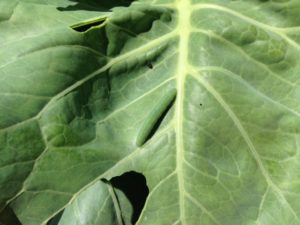 worm (ICW at left) continue in cole crop plantings in central and northern NJ, and adults are evident everywhere. With warmer temperatures now here, these infestations should increase rapidly. Check 5 consecutive plants each in 10 random locations throughout the planting, paying particular attention to the innermost leaves where ICW often feed (see photo at lower right). Consider treating if caterpillars are found on 10% or more plants that are in the 0-9 true leaf stage. From 9-leaf to the early head stage (in broccoli, cauliflower, and cabbage) infestations up to 20% may be tolerated. Once heads begin to form, a 5% threshold should be observed to protect the marketable portion of
worm (ICW at left) continue in cole crop plantings in central and northern NJ, and adults are evident everywhere. With warmer temperatures now here, these infestations should increase rapidly. Check 5 consecutive plants each in 10 random locations throughout the planting, paying particular attention to the innermost leaves where ICW often feed (see photo at lower right). Consider treating if caterpillars are found on 10% or more plants that are in the 0-9 true leaf stage. From 9-leaf to the early head stage (in broccoli, cauliflower, and cabbage) infestations up to 20% may be tolerated. Once heads begin to form, a 5% threshold should be observed to protect the marketable portion of 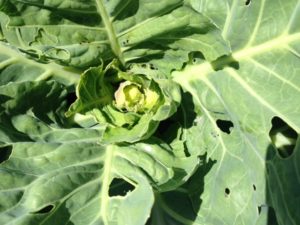 the plant. For leafy greens such as collards and kale, 10% plants infested is the threshold throughout.
the plant. For leafy greens such as collards and kale, 10% plants infested is the threshold throughout.
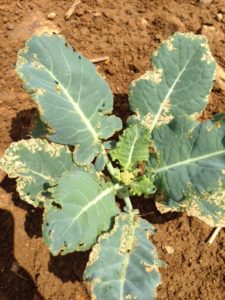 Flea beetles remain very active in a number of plantings, and warmer days will accelerate injury. Signs of “shot-hole” in leaves of host crops are an indication that flea beetles are present, even if the pests are not visible due to cold/wet weather. These pests have a preference for the “hotter” flavored crops like arugula, mustard greens, and turnip greens. They also attack Tuscan or lacinato kale frequently. Plants may be protected with at-planting, soil-applied neo-nicotinoid insecticides (see the 2024/25 Commercial Vegetable Production Recommendations for products). OMRI approved foliar materials for flea beetle management include Pyganic and Azera (pyrethrin + azadirachtin). These products will provide knock-down of flea beetles, but may need to be applied frequently on preferred host crops.
Flea beetles remain very active in a number of plantings, and warmer days will accelerate injury. Signs of “shot-hole” in leaves of host crops are an indication that flea beetles are present, even if the pests are not visible due to cold/wet weather. These pests have a preference for the “hotter” flavored crops like arugula, mustard greens, and turnip greens. They also attack Tuscan or lacinato kale frequently. Plants may be protected with at-planting, soil-applied neo-nicotinoid insecticides (see the 2024/25 Commercial Vegetable Production Recommendations for products). OMRI approved foliar materials for flea beetle management include Pyganic and Azera (pyrethrin + azadirachtin). These products will provide knock-down of flea beetles, but may need to be applied frequently on preferred host crops.
Tomatoes
Field scouting of outdoor and high tunnel tomatoes has begun. Low level aphid populations (see photo at right) have been found in a few tunnels. With plants in the vegetative or early flower stages, it is often acceptable to allow natural predation and parasitism to take its course. Beneficial insects such as syrphid fly maggots, ladybird beetles and parasitic wasps will frequently limit the advance of these early aphid populations before the advent of fruit production, especially if sides are left up in tunnels. This is particularly true if broad spectrum insecticides are avoided at this time. If aphid populations persist into the early/enlarging fruit stage, and their droppings are accumulating on fruit, aphid specific insecticides may be advisable. 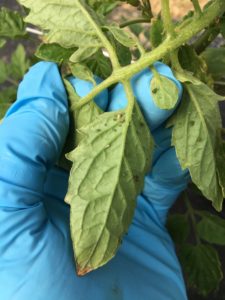 Growers should check tomatoes at least weekly, and note the presence of spider mites or aphids. Mites in particular should be treated early, so that they do not build to a population that becomes difficult to manage. Consider treating if aphids are found on multiple sites in a 5-site sample, and fruit are beginning to develop.
Growers should check tomatoes at least weekly, and note the presence of spider mites or aphids. Mites in particular should be treated early, so that they do not build to a population that becomes difficult to manage. Consider treating if aphids are found on multiple sites in a 5-site sample, and fruit are beginning to develop.
Peppers
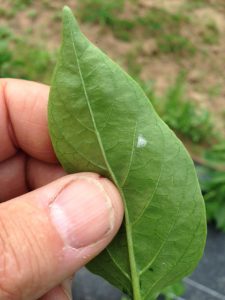 With ECB moth activity now occurring, growers should be looking for ECB egg masses (see photo at left) on the underside of pepper leaves. The larvae that hatch from these eggs will bore into the central stem of pepper plants in the absence of suitable fruit. This damage causes the tops of the plant to die, and eliminating the crown set of fruit in the process. Check 2 leaves per plant on 5 consecutive plants in 10 random locations. Consider treating if 2 or more leaves are found to have ECB larvae on the lower surface. Having said all that, there were very few instances of ECB injury on peppers in the central and northern counties over the past several years.
With ECB moth activity now occurring, growers should be looking for ECB egg masses (see photo at left) on the underside of pepper leaves. The larvae that hatch from these eggs will bore into the central stem of pepper plants in the absence of suitable fruit. This damage causes the tops of the plant to die, and eliminating the crown set of fruit in the process. Check 2 leaves per plant on 5 consecutive plants in 10 random locations. Consider treating if 2 or more leaves are found to have ECB larvae on the lower surface. Having said all that, there were very few instances of ECB injury on peppers in the central and northern counties over the past several years.
Thank you!
The Vegetable IPM Program wishes to thank the following Field Technicians, without whom much of the information presented weekly here would not be available:
Chris Cloutier
Hamna Khalid
Alexandra Suszko

